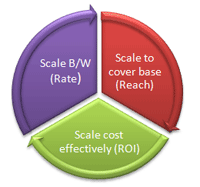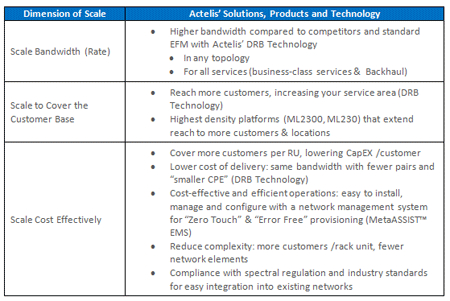Carriers worldwide have embarked on the path to deliver the necessary bandwidth to meet customer demand. They have built a portfolio of converged and cloud-based applications and services that fuel the demand for scaling higher bandwidth. The appetite for bandwidth and use of the applications that drive the demand for bandwidth is no longer the domain of only large enterprises (in the business context) and urban dwellers (in the residential context). Operators, therefore, must move beyond only providing additional bandwidth and supporting the applications to cost effectively scaling to meet the demand for higher bandwidth to every enterprise, regardless of location or distance from the central office.
There are several key elements of scale: the ability to deliver adequate bandwidth, the ability to cover the entire customer base, and the ability to deliver services cost effectively.
To deliver on all dimensions of scale operators must:
- Deliver competitive services that meet demand
- Build adequate and reliable capacity cost effectively (in backhaul networks and last/first mile services)
- Deliver services to majority of their customer base
- Manage network efficiently (deploy, install, support & troubleshoot)
- Leverage the existing resources (for speed and cost)

T1s and E1s were used (and bonded together, if necessary) to provide higher bandwidth services to enterprises and in backhaul networks. But, T1s and E1s are being rapidly replaced with Ethernet services. Of course, fiber is an alternative for delivering these services, but greenfield fiber deployments are hampered along two critical dimensions of scale: they are not cost effective and the long times associated with deployment means that fiber is decades away from being ubiquitous. Ethernet over copper is proving to be the alternative that is spelling the death of legacy T1s and E1s, providing an immediate alternative to fiber.

